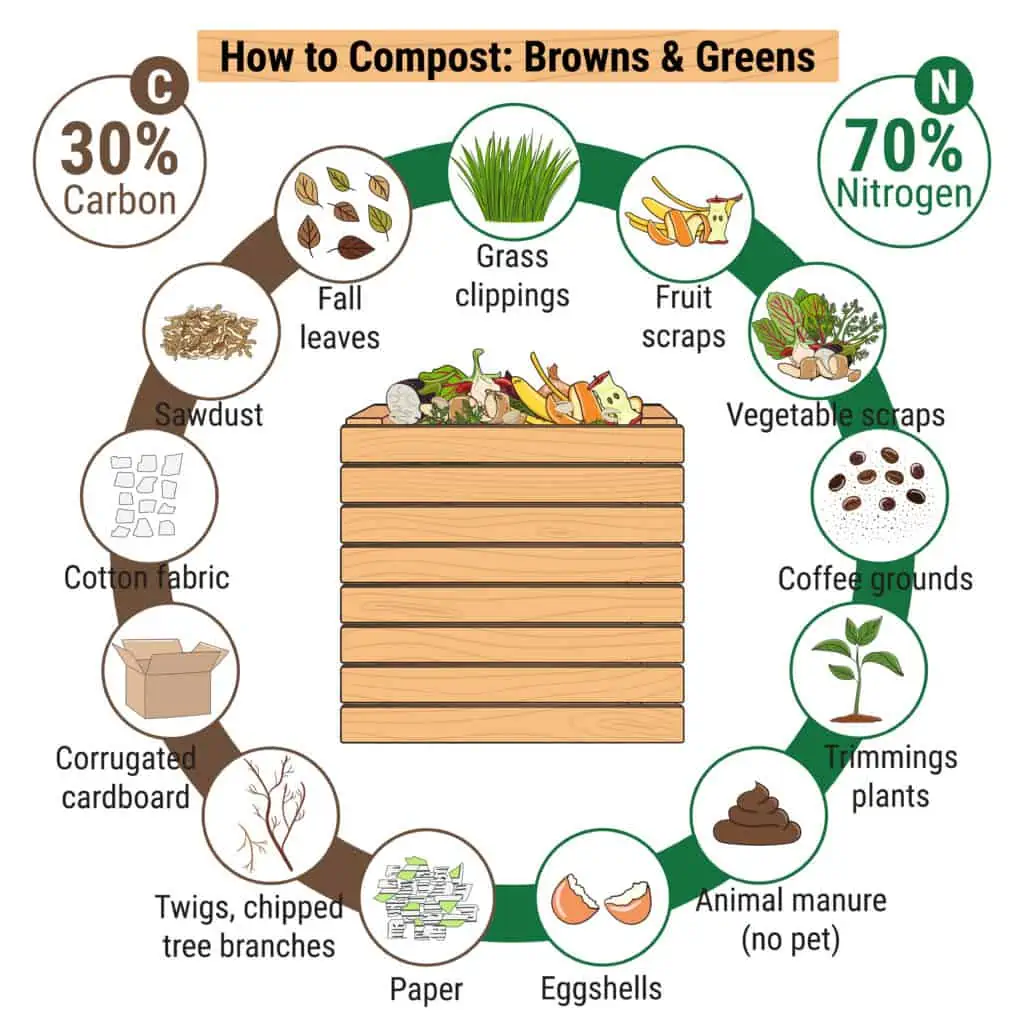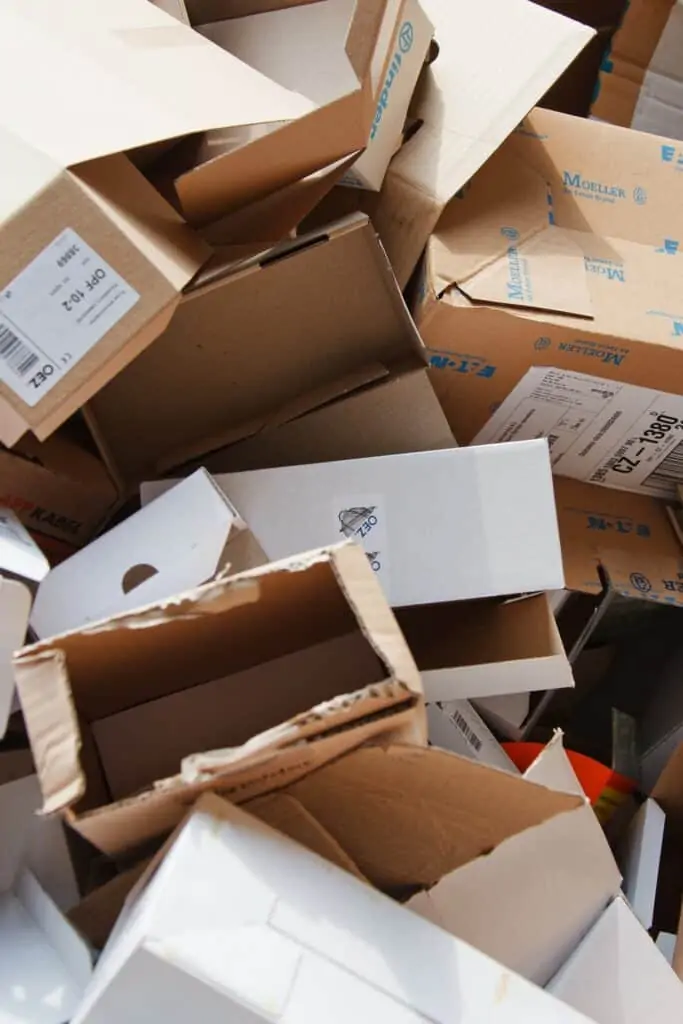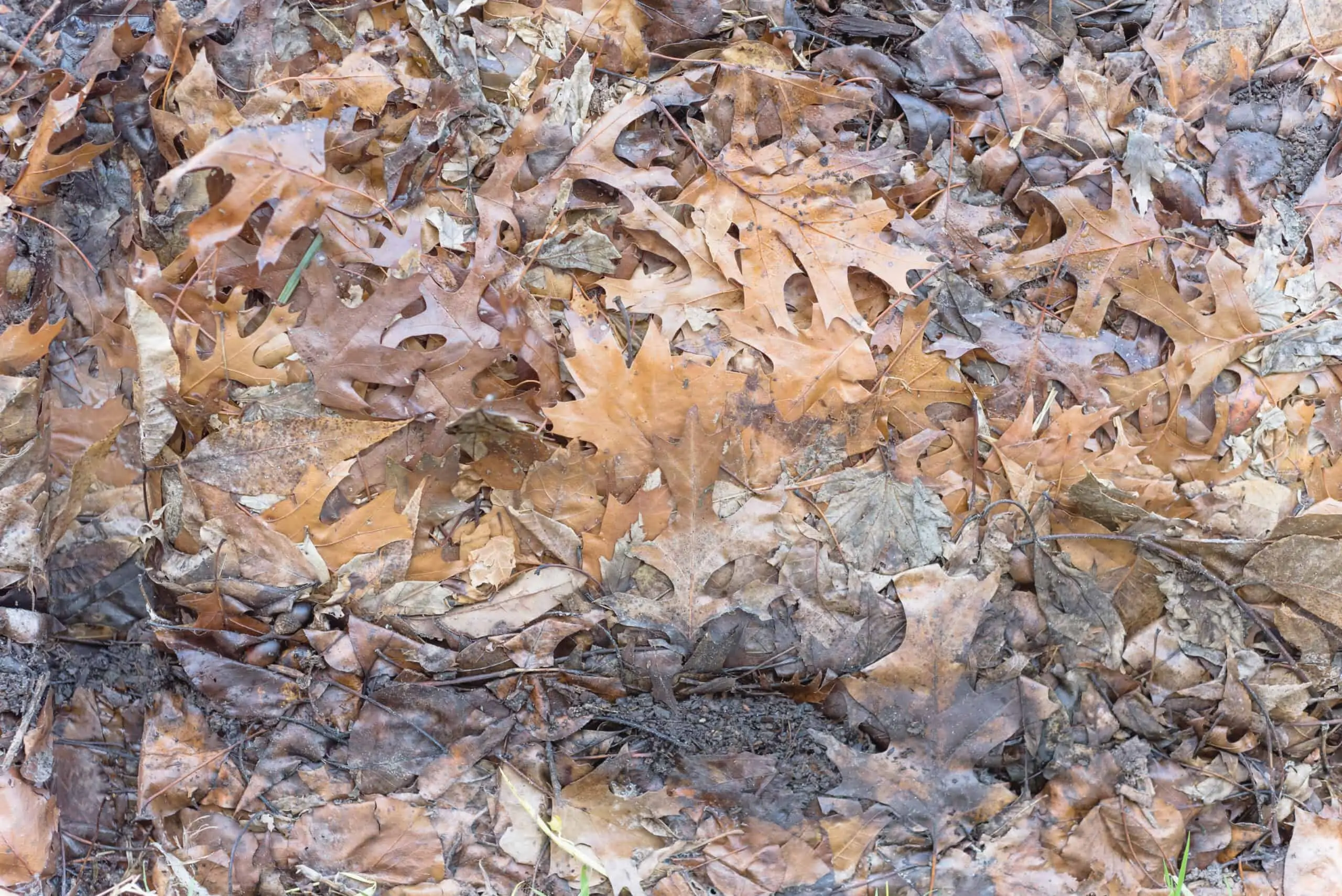As an Amazon Associate I earn from qualifying purchases.
Everything breaks down eventually. Whether it’s a pile of dead leaves that is gone in a year or two or a plastic water bottle that takes 450 years, eventually it will all return to the soil.
Composting attempts to do two things: make things return to the soil as fast as possible and make sure that, when it returns, it will be as beneficial as possible to the soil and to the plants that grow in it.
Composting Browns: The Key To Making Compost Fast
Let’s face it, most gardeners are steeped in tradition. Composting and gardening is hardly the place most people go for the most cutting-edge information on plants and plant growth.
Given that, I’m sure you can guess why most people refer to composting browns as “browns”. Yep, because of the color. The problem is, this confuses many people who are new to composting as not every brown item is carbon-rich and, even more importantly, the shade of brown doesn’t tell you anything at all about the carbon content/ratio.
In general, composting browns are considered to be items that are woody and/or fibrous in nature. Items such as structural components of plants (leaves, stalks, branches, etc.). In a more technical sense, brown items for composting are things with a high carbon-to-nitrogen ratio (“high” meaning greater than 30:1).
People who mistake every brown item for being carbon-rich may end up with compost which is a wet slurry that starts stinking, attracting bugs, and decomposing very slowly. In other words, they’re lacking carbon in the pile. Knowing what browns are best for your pile and how to add them will get your pile cooking and keep it from many of the most common problems.
As I talked about extensively in my article “The Truth About Composting Ratios” it’s not as simple as a carbon/nitrogen ratio.
Before we get to talking about all the browns, let me summarize it quickly:
- Microorganisms in your pile are responsible for breaking down your organic matter.
- To do this efficiently they need a diet that provides them with the proper materials in the proper amounts (ratios).
- The two main things that microorganisms need are not actually carbon and nitrogen. They need protein to build themselves/reproduce (protein is nitrogen-rich) and sugar for energy (carbon materials tend to be sugar/carb-rich).
Knowing exactly how to feed your pile will make sure that it is as efficient as possible. Without a sufficient energy source, your microorganisms will be forced to produce energy anaerobically. Which means you’ll have an inefficient and smelly pile.
But how do you know exactly what you need?
Perfecting Your Greens and Browns Ratio
You often hear people in forums and articles spouting that you need to get a “30:1 ratio for successful composting.” Thankfully, mother nature is not that precise. It is very difficult to figure out what the ratio of your pile could possibly be as every single green or brown has a different ratio. There aren’t just “greens” and “browns” but a spectrum of compost ingredients that run the entire gamut of carbon/nitrogen concentration.

Thankfully, getting your composting ratio of brown and greens correct is not something you have to do upfront. Once you have a composting pile (or tumbler) things will start breaking down. Down the road a bit it is easy to observe your compost and make corrections.
Instead of trying to figure out exact ratios when adding things, I simply try to keep everything a 2-3:1 by volume (in favor of browns) and add more as my pile tells me that it is in need.
How To Know If You Need More Browns In Your Compost
If you live in an apartment or compost on a small scale, it is highly probable that you are lacking in browns. Yard waste is a major source of browns for most people. If you are short on carbon, here’s what your pile will be doing:
- It will be too wet. Many nitrogen-rich items are also wet. Green veggies, grass clippings, manure, etc. will all introduce large amounts of water to your pile. If your pile is slimy or goopy, add browns!
- It will clump or ball up. Carbon-rich items tend to be extremely fibrous and add some structure to your pile. This aerates your pile and stops compost balls or clods from forming.
- It will stink. Just because your pile is stinking doesn’t necessarily mean that something is wrong. However, if you want to tame the smell (or your neighbors want you to) consider mixing in browns or covering your piles with browns such as dry leaves.
- It may be attracting bugs and pests. A pile that stinks and is too wet becomes a haven for flies, maggots, and even mosquitos. Drying it out a bit will dissuade pesky egg-laying creatures from visiting too often.
How To Know If You Need More Greens In Your Compost
Unless you have a large yard with oodles of waste, you’re probably going to be alright on greens. In fact, most people have trouble harvesting enough browns to keep pace with their greens production.
If, however, you get offered a large amount of a high-carbon compostable (such as sawdust) think twice before accepting. If you have a ton of carbon, your microorganism will eat and reproduce like crazy. Since they’ll have a lack of protein (nitrogen) to build their structures, however, they’ll start taking the nitrogen out of your soil in a process called nitrogen immobilization. Since nitrogen is one of the three essential nutrients for plant growth, this can negatively affect your soil.
Luckily, this can be fixed by simply adding in some more compostable greens. Here’s how you’ll know that you need them:
- Your pile will be decomposing slowly. If things are moving along extremely slowly and your pile isn’t heating up, try adding in a bunch of greens all at once. Some fresh manure or grass clipping does the trick for most people.
- Your pile will be dry. It’s easy to imagine how dried out you’d be feeling if you only had leaves and twigs to eat. Your compost is the same way. While every composting method needs occasional watering if you have a dry crusty pile you probably have too many browns.
- There will be minimal bugs, worms, etc. If your compost pile is inhospitable for small bugs and pests you can bet that it’s inhospitable for many beneficial microorganisms as well.
At the end of the day, your composting ratio is not something that you get right once. Knowing how many browns to add to your pile is something that you will constantly be figuring out with every pile you ever have.
The Most Common Composting Browns (And How To Add Them)
When looking at the best composting brown, it’s typically best to focus on options that are in the low to middle range of the C/N ratio. This means that you should only use highly concentrated carbon sources such as sawdust or wood chips sparingly (at least to start off with).
If this is a bit confusing, just try to stay away from materials that have a higher C/N ratio of 400:1 unless your compost is in need of a major correction.
| Carbon Source | C/N Ratio |
|---|---|
| Twigs, Branches, and Wood Chips | 600:1 |
| Fresh Sawdust | 500-600:1 |
| Cardboard | 350-550:1 |
| Office/Printer Paper | 170:1 |
| Shredded Newspaper | 170:1 |
| 3-Year-Old Sawdust (Weathered) | 140:1 |
| Bark | 130-1280:1 |
| Paper Towels | 110:1 |
| Wheat Straw | 100:1 |
| Hay | 75:1 |
| Tissue/Toilet Paper | 70:1 |
| Corn Cobs | 55-120:1 |
| Pine Needles | 60-100:1 |
| Corn Stalks | 60:1 |
| Peat Moss | 55:1 |
| Dried Leaves | 40-80:1 |
| Fresh Leaves | 37:1 |
| Nut Shells | 35:1 |
| Straw | 50-150:1 |
| Paper Products | 200-800:1 |
| Fresh Sawdust | 400:1 |
| Wood ash | 25:1 |
While they aren’t the most exciting or highly concentrated sources, these are the 10 composting browns that I feel most people will have luck with:
Dry Leaves
When it comes to easy-to-access carbon sources, dry leaves have to be at the top of every gardener’s list. In fact, many people bag up leaves and store them when they are plentiful so they have a readily available brown to compliments the greens they add during the rest of the year.
Leaves are an excellent addition to compost as they have a relatively mild carbon/nitrogen ratio of around 60:1. While they will decompose faster if they are processed first, adding whole leaves to your pile is fine. They will continue to break down in the ground even after you have spread your compost.
Paper Products
Nearly every paper product is fine to add to your compost, as long as it is just a paper product. Plasticized paper, toxic inks, and adhesives all make the product a no-no.
Given that, there are many safe paper products that you can compost to add some carbon to your pile:
- Newspaper
- Office paper or junk mail
- Parchment paper
- Toilet Paper and Tissues
Just remember that the smaller the pieces are when they go into your compost, the faster they will break down!
Cardboard

Shredding cardboard for a compost pile is the bane of millions of gardeners. While it’s not that hard, it can be time-consuming.
However, it is worth it as cardboard is an extremely plentiful source of carbon, especially for people who don’t have access to leaves or woody plant trimmings.
When adding cardboard to your compost pile, just make sure that you have removed all labels, tape, etc., and processed it as far as you are able.
Straw/Hay
It’s commonly known that alfalfa meal is one of the best natural fertilizers that you can get. Less known, however, is the fact that hay/straw can often be added to your compost or soil in a whole state.
Straw has a relatively mild C/N ratio of 50-150:1 and is an excellent choice for compost that is sticking or clumping together. While it doesn’t have a lot to add in terms of nutritional value, it will help keep things aerated and remember, oxygen is an integral part of composting too!
Pine Needles
Many people fear pine needles in their yard/garden for two reasons: they break down super slowly, and people think that they are acidic enough to harm soil/plants.
The first is true, the second, not so much. While adding pine needles to your compost may temporarily lower the pH, the benefits of the additional carbon can make it worth it, especially if you don’t plan to harvest your compost for a year or two.
Plant Trimmings
Along with leaves, woody plant trimming are some of the most plentiful yard sources of carbon. Common composting browns here include bush trimmings, chipped wood, old mulch, bark, and even dried weeds.
Just be sure that, if you are composting seeds, your pile is hot enough to kill them off or you will simply be spreading them to new even more fertile locations when you spread your compost!
Corn Stalks/Cobs
If you actually grow veggies in your garden, nearly everything that is left over after the harvest can be composted. King among these is corn cobs and corn stalks. Both take a significant amount of time to break down but are excellent mid-range carbon sources (around 60:1 for corn stalks).
Nut Shells
Pistachio shells, peanut shells, and most other woody husks are good sources of compostable carbons. While they take a long time to break down (years, in some cases) this can be expedited if you stick them into your food processor or blender before dumping them onto your compost.
While they are less common, some other brown composting materials that may be available to you include items such as:
- Fabric
- Pine Cones
- Dryer Lint
- Coffee Filters
- Coconut Husks
- Wool
- Bird Nests
- Napkins
- Peat Moss
- Tea Bags
- Pine Cones
- Egg Cartons
Sourcing Browns: Where To Find Carbon-Rich Composting Materials
But what if you need more brown materials for your compost? Well, luckily, they’re easy to find out in the wild than greens are. Here are five of the ways I’ve gone about gathering up more brown materials for my pile:
- Beg your neighbors. Walk around your neighborhood and keep an eye on houses that have bags of leaves gathered up. Simply asking if you can have them for your yard might net you a bushel of leaves every coming season. You can also offer to rake yards with lots of leaves in exchange for keeping them.
- Ask for remnants. Most businesses (especially ones trying to be green) need something to do with their waste. If you’re lucky, that might mean they’ll donate it to your composting mission. Coffee grounds from cafes, apple mash from cider factories, grape skins from wineries, cottonseed hulls from cotton gins, and more can be used to great effect!
- Call landscapers. Most businesses that mow lawns or trim trees have to pay to dump the waste that they remove. If you are willing to take it for free they just might be over the moon! Just be aware that they probably won’t be willing to just come to drop off a few leaves at your house on the way to the dump. It will probably be all or nothing of what’s in their truck at the time. It can also pay off to talk to electric companies or other organizations that have to trim trees or do public landscaping projects.
- Talk to farmers. Local stables, dairies, and farms can all be a source for one of my favorite composting products: manure. While most large farms have waste management programs in place to deal with the poop, many family farms will gladly let you take a load of the brown goodness, especially if you’re willing to remove it yourself.
- Hit up grocery stores. In the United States, grocery stores produce an astronomical amount of waste. In fact, Rob Greenfield traveled across the entire country eating only what he found in dumpsters. While that might not be for me, I do appreciate the chance to take out food that would otherwise be thrown away and route it to my compost pile instead. Day-old produce, non-sugary baked goods, and more are all fair game if you find a friendly manager!
The best advice I can give you if you’re struggling to get enough browns to compost is to stockpile them when you find them. Dedicating a bin to leaves or a spot in your yard to cardboard or paper can make all the difference during lean times!
Carbon-Rich Browns To AVOID Adding To Your Compost
Apart from the obvious things (such as your own feces) that you shouldn’t add to your compost pile, there are several less obvious things that can be harmful to your progress. Here are a couple of brown materials that should not make their way into your pile:
- Treated wood. If you are looking to use wood as a carbon source, stick to naturally harvested varieties. If someone offers you sawdust, be sure to ask if it’s from pressure-treated or chemically-treated wood as both can introduce nasty toxins into your compost.
- Ashes. While many old-timers swear by spreading some ashes onto your compost, it can do more harm than good. Wood ashes are alkaline so, unless you live in an area with acidic soil, it won’t have any benefits. If you do need them, a small handful over your compost is typically sufficient.
- Charcoal or BBQ briquettes. Keep these out of your pile! They typically contain sulfur oxides and other nasty additives that will kill plants and your beneficial bugs.
- Fecal matter. It should go without saying but I’m going to mention feces here, mostly because they’re brown and people think they’re great for the soil. They’re usually not. Waste from dogs, cats, people, birds, pigs, and rodents often have harmful pathogens and parasites that you don’t want in your soil. These can actually make their way into produce that you grow (or into a toddler’s mouth) and cause disease and infection. Even if it is not riddled with disease, fecal matter is often not balanced well and can “burn” your plants (by having excess nitrogen for example).
- Meat, grease, bones, etc. While most types of meat can actually be composted, doing so is often smelly and attracts too many pests. Avoid items of this variety if you’re trying to compost the easy way.
Apart from those items, most carbon-rich sources are fair game. I typically imagine whether I could find an item on a forest floor and, if I can, it goes into my pile.
Conclusion
Hopefully, you’ll soon figure things out to the point that you no longer need a composting greens and browns list. However, knowing what browns are best for composting is integral to giving your little microbiome the carbon it needs to grow.
So get out there and rake some leaves!

